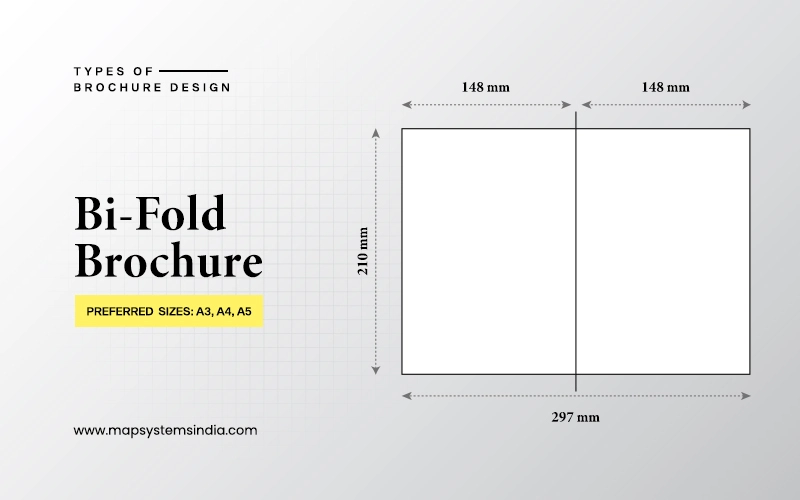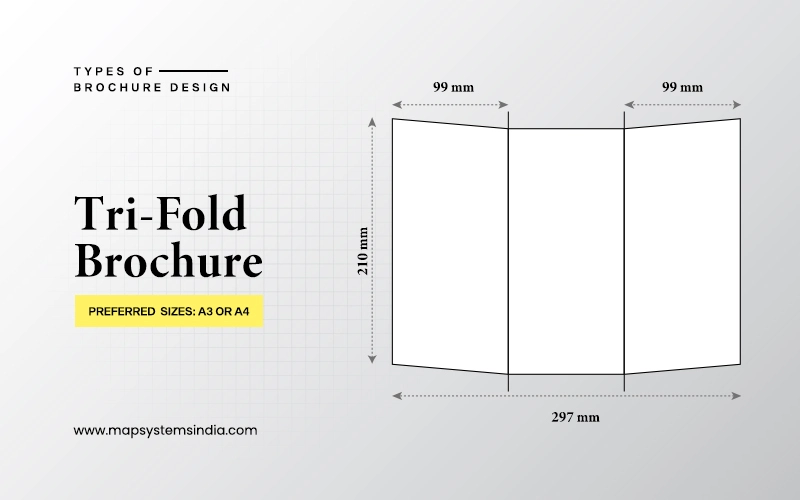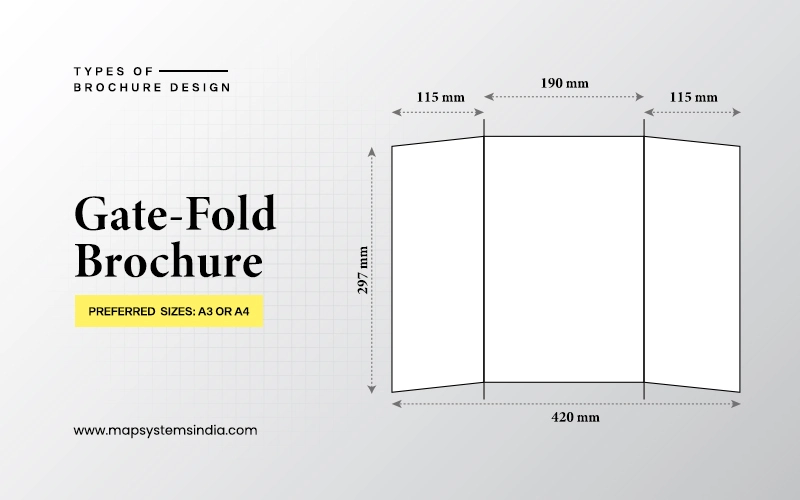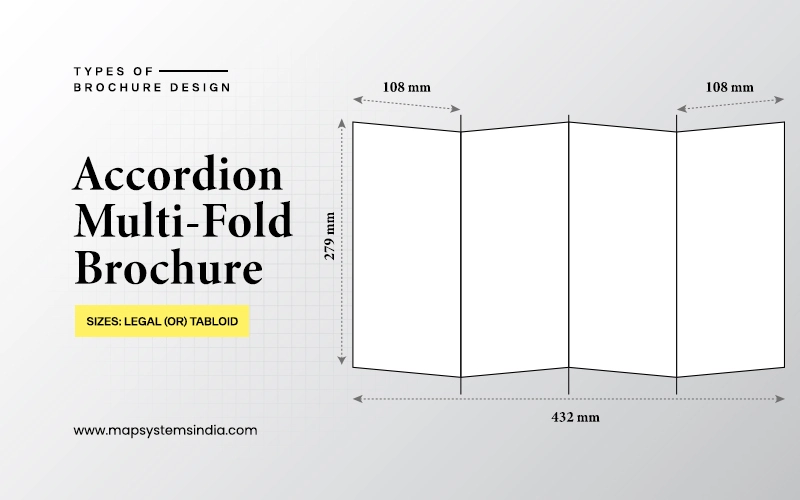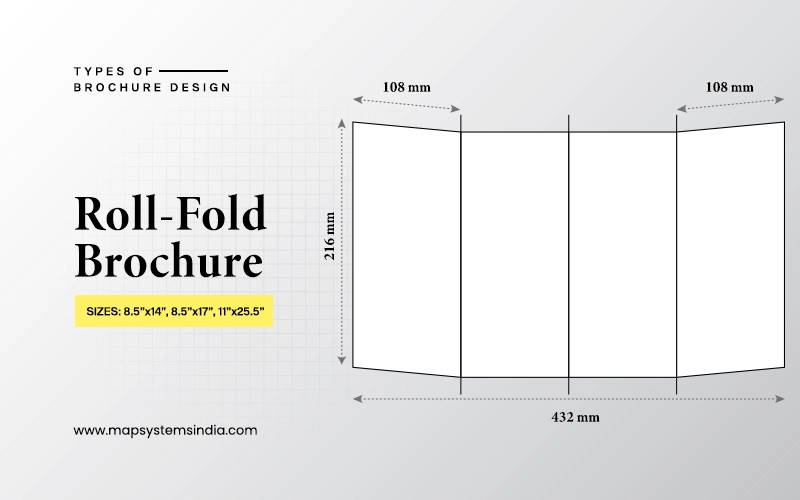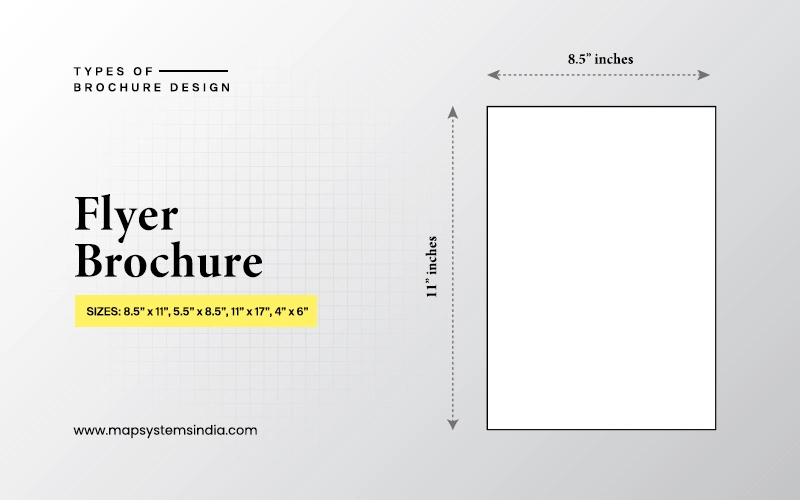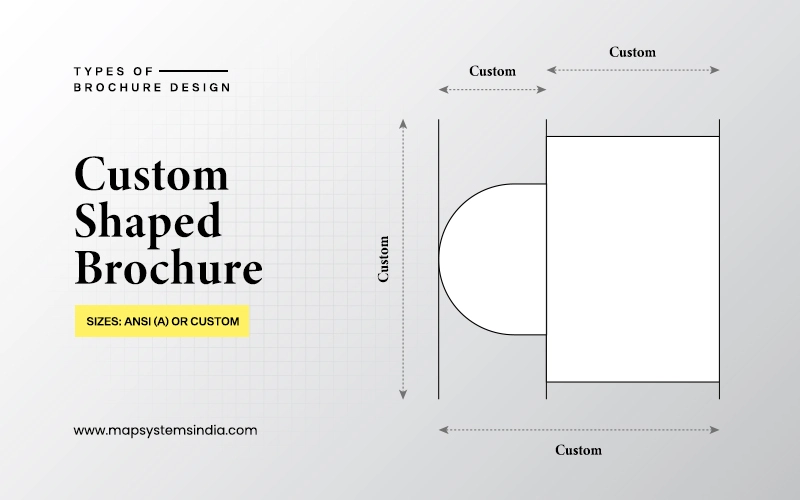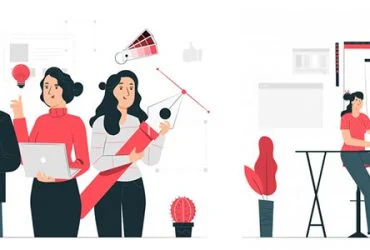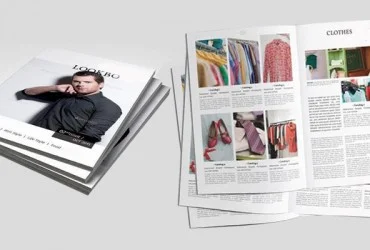A Complete Guide on 15 Types of Brochure Designs for Your Business
Brochures are an essential component of any marketing strategy, offering businesses an opportunity to reach their audience in a direct, tangible way. Whether you're designing a print brochure or an e-brochure, it’s important to ensure the design effectively conveys the message and grabs attention. Printed brochures, in particular, have the added challenge of being finalized without the option for immediate changes, making it vital to work with top graphic design firms to get it right.
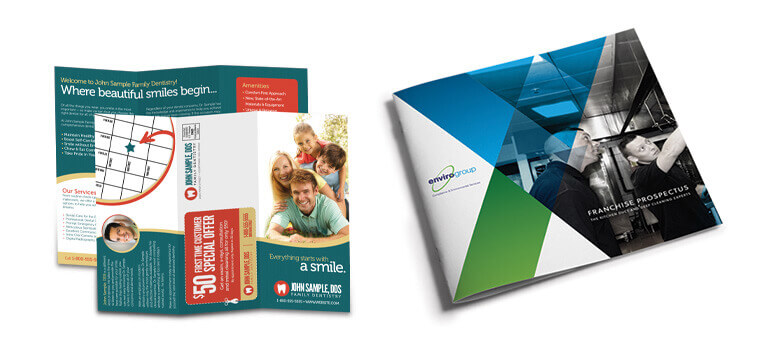
When creating a brochure, it’s essential to consider your brochure design goals. This involves understanding the purpose of the brochure, your target audience, and the key selling points (USPs) you want to highlight. Brochure fold types are a common consideration, but other brochure design elements—like layout, visuals, and content—play a huge role in determining success.
Let’s look at several popular types of brochure designs and how they can enhance your marketing efforts.
-
Bi-Fold Brochure Design
A bi-fold brochure consists of two panels, creating four sections when folded. It provides a clean, professional look and is easy to handle.The size of a bi-fold brochure is 8.27 x 5.83 inches or 210 x 148 millimeters.
When to Use Bi-Fold Brochure?
- Corporate Presentations: Ideal for professional business proposals and company introductions.
- Product Showcases: Suitable for catalogs that highlight key products with concise descriptions.
- Event Invitations: Great for formal event promotions and exclusive gatherings.
- Portfolios: Best for showcasing work in a structured, elegant manner.
- Educational Materials: Used in training programs, academic brochures, and course outlines.
Benefits of Bi-Fold Brochure
- Easy to Read: The two-panel layout keeps information organized.
- Cost-Effective: Requires less printing and design effort.
- Professional Appeal: Often used in corporate settings for an elegant presentation.
- Compact Design: Easily fits into standard envelopes or display stands.
- Versatile: Can be adapted for any industry or purpose.
-
Tri-Fold Brochure Design
A tri-fold brochure has three panels, providing six sections when fully opened. It allows businesses to present more information in an engaging way. The standard dimension of a tri-fold brochure design is 8.5" × 11" (US Letter) when unfolded.
When to Use Tri-Fold Brochure?
- Step-by-Step Guides: Perfect for instructional content and processes.
- Marketing Campaigns: Works well for storytelling and brand promotion.
- Restaurant Menus: Ideal for listing multiple items in a structured format.
- Travel Guides: Suitable for itineraries and tourist brochures.
- Business Promotions: Great for service listings and customer engagement.
Benefits of Tri-Fold Brochure
- More Space for Information: Six sections allow detailed content presentation.
- Highly Engaging: The format creates a natural reading flow.
- Compact Yet Informative: Folds neatly while containing a lot of information.
- Popular and Widely Recognized: Clients and customers find them familiar and easy to use.
- Visually Appealing: Designed for creative layouts and vibrant imagery.
-
Z-Fold Brochure Design
A Z-fold brochure features three equal panels that fold into a zigzag shape, making it an interactive and dynamic choice. The standard dimension of a Z-fold brochure is 8.5" x 11" (letter size) when unfolded, with each panel measuring approximately 3.67" x 8.5" after folding.
When to Use Z-Fold Brochure?
- Process Flows: Best for visualizing timelines and step-by-step guides.
- Travel Itineraries: Ideal for presenting destination highlights and schedules.
- Product Demonstrations: Works well for showcasing before-and-after comparisons.
- Event Schedules: Suitable for organizing conference or seminar details.
- Advertising Flyers: Great for promotional offers and brand awareness.
Benefits of Z-Fold Brochure
- Engages the Reader: The unfolding experience keeps attention intact.
- Distinct Design: Stands out from traditional folds.
- Easy Navigation: Works well for sequential storytelling.
- Compact and Organized: Folds neatly while maintaining structure.
- Ideal for Illustrations: Allows for larger graphics and creative layouts.
-
Gate-Fold Brochure Design
A gate-fold brochure consists of two outer panels that open like doors, revealing a central section inside. The standard dimension of a gate-fold brochure is 8.5" x 11" (when folded) and 17" x 11" (when fully open).
When to Use Gate-Fold Brochure?
- Luxury Brand Promotions: Perfect for premium services and high-end marketing.
- Special Announcements: Ideal for unveiling new products or exclusive launches.
- Event Invitations: Creates anticipation for special events and grand openings.
- High-Impact Advertising: Best for campaigns that need a dramatic visual impact.
- Portfolio Presentations: Great for displaying artistic works in a stylish manner.
Benefits of Gate-Fold Brochure
- Highly Aesthetic: Offers a luxurious and sophisticated look.
- Creates Suspense: Encourages engagement through the unfolding experience.
- Great for Branding: Enhances brand perception and exclusivity.
- Maximizes Visual Appeal: Best suited for large, high-quality images.
- Ideal for High-Impact Messaging: Works well for premium services.
-
Accordion Fold Brochure Design
An accordion fold brochure consists of multiple folds, resembling the bellows of an accordion, making it perfect for presenting structured information. The standard dimension of an Accordion Fold Brochure is 8.5" × 14" (legal size) or 11" × 17" (tabloid size), folded into equal panels.
When to Use an Accordion Fold Brochure?
- When presenting a large volume of information in a structured format: Ideal for displaying detailed content without overwhelming the reader.
- For step-by-step guides that require sequential flow: Helps in breaking down complex processes into clear, digestible steps.
- When storytelling in a progressive manner: Enhances brand narratives, travel itineraries, or historical timelines.
- For technical product descriptions and user manuals: Ensures easy navigation through specifications, features, and instructions.
- When a compact yet comprehensive format is required: Offers portability without compromising on the depth of information.
Benefits of Accordion Fold Brochure
- Ensures easy reading with a well-structured flow
- Prevents content overload by dividing information into sections
- Ideal for educational or instructional content
- Portable and convenient for readers
- Enhances visual appeal with clear divisions
-
Roll-Fold Brochure Design
A roll-fold brochure folds inward multiple times, creating a sleek, compact, and easy-to-follow layout. The standard roll-fold brochure design dimensions are 8.5" x 14", 8.5" x 17", or 11" x 25.5", depending on the number of folds.
When to Use a Roll-Fold Brochure?
- For presenting sequential information in a step-by-step manner: Ensures smooth content progression for instructional materials.
- When designing product manuals that require clear guidance: Helps users understand technical details and assembly instructions effortlessly.
- For healthcare and medical brochures with patient guidelines: Organizes medical instructions, prescriptions, and dosages effectively.
- When showcasing corporate profiles with a structured narrative: Presents company history, achievements, and services in a professional layout.
- When a professional and polished look is essential: Creates an elegant format ideal for business events, high-end services, and official documentation.
Benefits of Roll-Fold Brochure
- Presents information in a compact, easy-to-navigate format
- Enhances readability with structured sections
- Offers a premium feel suitable for corporate and technical industries
- Protects sensitive content by concealing inner pages
- Smooth and refined folding mechanism improves durability
-
Square Brochure Design
A square brochure deviates from traditional rectangular designs, making it a unique choice for brands that want to stand out. The standard dimension for a square brochure design is 8" x 8" or 6" x 6", but it can vary based on design preferences.
When to Use a Square Brochure?
- When you need to make a bold visual statement: The unconventional shape grabs attention instantly.
- For creative industries that thrive on aesthetics: Perfect for artists, photographers, and designers who rely on visual impact.
- When presenting luxury or boutique brand offerings: Elevates the brand’s premium appeal with a distinctive format.
- For fashion lookbooks and trend showcases: Displays collections with a modern, high-end feel.
- When emphasizing high-quality imagery and visuals: Ideal for portfolios, real estate listings, and architectural presentations.
Benefits of Square Brochure
- Attracts attention due to its unique shape
- Perfectly balances creativity and professionalism
- Allows for eye-catching, full-page visuals
- Enhances brand recall and recognition
- Encourages interaction and engagement
-
Flyer Brochure Design
A flyer brochure is a single-page format that is perfect for fast, high-impact marketing and mass distribution. The standard flyer brochure design dimensions are 8.5" x 11" (letter size), but other common sizes include 5.5" x 8.5" (half letter), 11" x 17" (tabloid), and 4" x 6" (postcard size) depending on the design requirements.
When to Use a Flyer Brochure?
- When you need a cost-effective marketing tool for promotions: Ideal for limited-time offers and seasonal campaigns.
- For large-scale event advertising and announcements: Distributes information quickly to a wide audience.
- When creating high-visibility materials for brand awareness: Ensures that your business stands out at trade shows and public spaces.
- For restaurant menus, discount deals, and service listings: Highlights key offerings in an easy-to-read format.
- When reaching potential customers with direct, concise messaging: Keeps information straightforward, making it easier for people to absorb.
Benefits of Flyer Brochure
- Highly affordable and easy to print in bulk
- Simple yet impactful messaging grabs attention instantly
- Easy to distribute in various locations
- Encourages immediate action from potential customers
- Versatile design allows for both visuals and text
-
Custom-Shaped Brochure Design
A custom-shaped brochure is tailored to align with a brand’s identity, making it a standout marketing tool. The dimension of a Custom-Shaped Brochure Design varies based on the shape and design requirements but typically falls within standard brochure sizes like 8.5" x 11", 5.5" x 8.5", or custom die-cut dimensions.
When to Use a Custom-Shaped Brochure?
- When creating a unique and unforgettable brand experience: Leaves a lasting impression by moving beyond standard formats.
- For luxury brand promotions that demand exclusivity: Aligns with premium branding by offering an elegant, bespoke design.
- When launching a new product and aiming for strong brand recall: Helps establish a distinct identity with a custom, theme-driven design.
- For themed marketing campaigns that require innovative presentation: Matches seasonal promotions, event-based marketing, or industry trends.
- When you want to differentiate from competitors in a crowded market: Creates a distinct visual appeal that draws immediate attention.
Benefits of Custom-Shaped Brochure
- Highly engaging and visually striking
- Boosts brand memorability by standing out from conventional formats
- Increases perceived value and exclusivity
- Encourages customer curiosity and interaction
- Customizable to match specific branding needs
Other types of brochure design
Direct mail brochures
Direct mail brochures are used to send marketing materials directly to prospective customers via postal mail. Since these brochures are unsolicited, the design should capture the recipient's attention immediately. Direct mail marketing is all about concise, engaging content with a clear call to action. Use bold visuals and simple text to make sure the reader can easily identify your product or service’s benefits. Don't forget to highlight your contact details in a prominent position to encourage response.
Sales support brochures
Sales support brochures are created to aid your sales team by providing them with an informative and visually engaging tool to present to prospects. These brochures are effective for showcasing products or services, especially when there is a need to convey complex information. Use structured designs with headings, bullet points, images, and charts to make the brochure easily digestible. A well-designed sales brochure can help your team better communicate the value of your offering and ultimately increase sales conversions.
Enquiry Response Brochures
Enquiry response brochures are targeted marketing materials designed for customers who have already expressed interest in your product or service. These brochures should respond to their specific queries, offering in-depth information about the product’s features, benefits, and value proposition. Use customer testimonials, case studies, and high-quality imagery to make the brochure both informative and persuasive. Targeted brochures like these are essential for converting interest into sales, as they cater directly to a customer's needs.
Leave Behind Brochures
A leave behind brochure is a marketing tool handed to potential clients after a sales pitch or meeting. This brochure serves as a reminder of your conversation and reinforces your product’s benefits. Since you might not always be able to speak to the decision-maker directly, these brochures should focus on highlighting your unique selling points (USPs) and ensuring your business stands out. Even though a call to action might not always be necessary, your contact details should be clearly visible to encourage follow-up.
Point of Sale Brochures
Point of sale brochures are placed in high-traffic areas like trade shows, exhibitions, or retail stores, where customers are likely to pick them up on impulse. These brochures should be designed to capture attention quickly. Use compelling text, attractive offers, and eye-catching images to entice potential customers. Offering limited-time offers, discounts, or special promotions can further increase engagement and drive impulse purchases. A point of sale brochure is all about making an immediate connection with the reader.
Handouts
In situations where you can’t reach customers in a physical location or don’t have their contact details, handout brochures are an excellent solution. These brochures should be designed to capture attention even without personal interaction, inviting potential customers to take a closer look. Quality stock paper and professional design are crucial here to convey trustworthiness. Combine attractive visuals with compelling copy to engage the reader from the front cover to the last page. A handout brochure is most effective when combined with knowledgeable staff to distribute and engage with prospects.
Conclusion
When choosing a brochure design for your business, it's important to consider your target audience, marketing objectives, and the key message you want to communicate. Whether you opt for a direct mail brochure, sales support brochure, or a handout brochure, each design serves a specific purpose and should be tailored to meet your needs. By selecting the right brochure fold types and integrating compelling content and visuals, you can create a marketing brochure that grabs attention and encourages action.
For businesses looking to ensure the success of their brochure designs, collaborating with professional brochure design services is crucial. These experts can help craft the perfect design tailored to your goals and target audience. Additionally, incorporating sales brochure design ideas that highlight your unique selling points, features, and benefits will elevate your marketing efforts, boost engagement, and increase conversion rates. Whether it's through print or digital channels, a well-designed brochure can be a powerful tool to enhance your brand’s visibility and drive measurable results.
Frequently Asked Questions
To choose the right brochure type, consider your purpose, target audience, and content volume. Common formats include bi-fold, tri-fold, gate-fold, and Z-fold. A tri-fold works well for marketing, while a bi-fold is ideal for product catalogs. Select a format that best presents your information and engages your audience.
A brochure design format refers to the layout and structure of a brochure, including its size, fold type, and orientation. Popular formats include bi-fold, tri-fold, Z-fold, and gate-fold. The format determines how content is displayed, making it crucial for effective communication and brand presentation.
To design a brochure, define your purpose, choose a suitable format, and maintain a visually appealing layout. Use high-quality images, concise text, and brand colors. Ensure readability with proper font selection and white space. Professional design tools like Adobe InDesign or Canva help create polished brochures.
Companies use brochures for marketing, product promotion, and brand awareness. Brochures provide a tangible way to present information, engage customers, and drive conversions. They are cost-effective, easy to distribute, and effective in trade shows, meetings, or direct mail campaigns.

